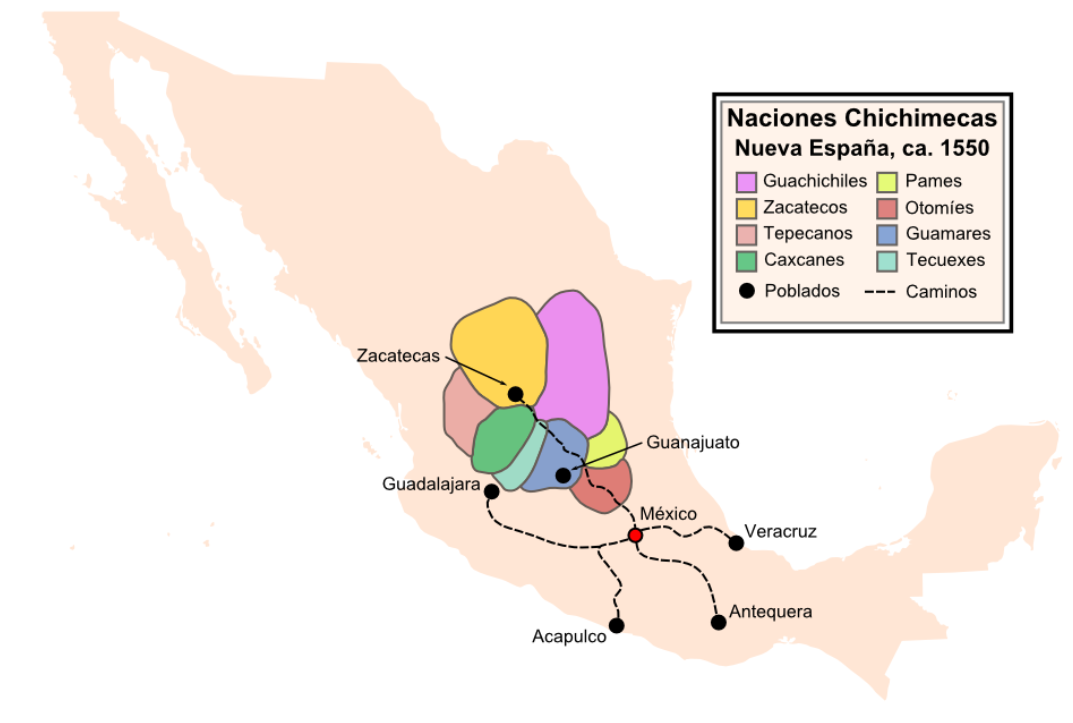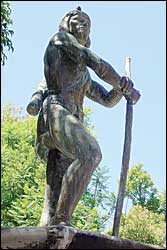|
Mexican Indian Wars
Indigenous rebellions in Mexico and Central America were conflicts of resistance initiated by Indigenous peoples against European colonial empires and settler states that occurred in the territory of the continental New Spain, Viceroyalty of New Spain and British Honduras, as well as their respective successor states. The latter include Mexico, Guatemala, Honduras, Belize, El Salvador, Nicaragua, Costa Rica, and parts of the Southern United States, Southern and Western United States, Western United States. Anti-colonial rebellions by the Indigenous peoples of Central America had precedence in resistance to the Aztec Empire prior to the Spanish conquest of the Aztec Empire, Spanish conquest. During the period of Spanish rule, encomienda, forced labor, the expansion of colonial territory, and the forceful Reductions, reduction of disparate communities into villages or missions where Christianity was enforced were common causes of revolt. After independence, continued encroachment on ... [...More Info...] [...Related Items...] OR: [Wikipedia] [Google] [Baidu] |
Encomienda
The ''encomienda'' () was a Spanish Labour (human activity), labour system that rewarded Conquistador, conquerors with the labour of conquered non-Christian peoples. In theory, the conquerors provided the labourers with benefits, including military protection and education. In practice, the conquered were subject to conditions that closely resembled instances of forced labour and slavery. The ''encomienda'' was first established in Spain following the Christian Reconquista, and it was applied on a much larger scale during the Spanish colonization of the Americas and the Spanish East Indies. Conquered peoples were considered vassals of the Spanish monarch. The Crown awarded an ''encomienda'' as a grant to a particular individual. In the conquest era of the early sixteenth century, the grants were considered a monopoly on the labour of particular groups of indigenous peoples, held in perpetuity by the grant holder, called the ''encomendero''; starting from the New Laws of 1542, t ... [...More Info...] [...Related Items...] OR: [Wikipedia] [Google] [Baidu] |
Chichimeca
Chichimeca () is the name that the Nahua peoples of Mexico generically applied to nomadic and semi-nomadic peoples who were established in present-day Bajío region of Mexico. Chichimeca carried the same meaning as the Roman term "barbarian" that described Germanic tribes. The name, with its pejorative sense, was adopted by the Spanish Empire. In the words of scholar Charlotte M. Gradie, "for the Spanish, the Chichimecas were a wild, nomadic people who lived north of the Valley of Mexico. They had no fixed dwelling places, lived by hunting, wore little clothes and fiercely resisted foreign intrusion into their territory, which happened to contain silver mines the Spanish wished to exploit."Gradie, Charlotte M. "Discovering the Chichimecas" ''Academy of American Franciscan History'', Vol 51, No. 1 (July 1994), p. 68 Gradie noted that Chichimeca was used as a broad and generalizing term by outsiders, writing, " twas used by both Spanish and Nahuatl speakers to refer collectively to ... [...More Info...] [...Related Items...] OR: [Wikipedia] [Google] [Baidu] |
Spanish Empire
The Spanish Empire, sometimes referred to as the Hispanic Monarchy (political entity), Hispanic Monarchy or the Catholic Monarchy, was a colonial empire that existed between 1492 and 1976. In conjunction with the Portuguese Empire, it ushered in the European Age of Discovery. It achieved a global scale, controlling vast portions of the Americas, Africa, various islands in Asia and Oceania, as well as territory in other parts of Europe. It was one of the most powerful empires of the early modern period, becoming known as "the empire on which the sun never sets". At its greatest extent in the late 1700s and early 1800s, the Spanish Empire covered , making it one of the List of largest empires, largest empires in history. Beginning with the 1492 arrival of Christopher Columbus and continuing for over three centuries, the Spanish Empire would expand across the Caribbean Islands, half of South America, most of Central America and much of North America. In the beginning, Portugal was ... [...More Info...] [...Related Items...] OR: [Wikipedia] [Google] [Baidu] |
Chichimeca War
The Chichimeca War (1550–1600) was a military conflict between the Spanish Empire and the Chichimeca Confederation established in the territories today known as the Central Mexican Plateau, called by the Conquistadores La Gran Chichimeca. The epicenter of the hostilities was the region now called the Bajío. The Chichimeca War is recorded as the longest and most expensive military campaign confronting the Spanish Empire and indigenous people in Aridoamerica. The forty-year conflict was settled through several peace treaties driven by the Spaniards which led to the pacification and, ultimately, the streamlined integration of the native populations into the New Spain society. The Chichimeca War (1550–1600) began eight years after the two-year Mixtón War. It can be considered a continuation of the rebellion as the fighting did not come to a halt in the intervening years. The war was fought in what are the present-day Mexican states of Zacatecas, Guanajuato, Aguascaliente ... [...More Info...] [...Related Items...] OR: [Wikipedia] [Google] [Baidu] |
Zacatecas
Zacatecas, officially the Free and Sovereign State of Zacatecas, is one of the Political divisions of Mexico, 31 states of Mexico. It is divided into Municipalities of Zacatecas, 58 municipalities and its capital city is Zacatecas City, Zacatecas. It is located in north-central Mexico and is bordered by the states of Durango to the northwest, Coahuila to the north, Nayarit to the west, San Luis Potosí and Nuevo León to the east, and Jalisco, Guanajuato and Aguascalientes to the south. The state is best known for its rich deposits of silver and other minerals, its Spanish Colonial architecture, colonial architecture and its importance during the Mexican Revolution. Its main economic activities are mining, agriculture and tourism. Geography Zacatecas is located in the center-north of Mexico, and covers an area of 75,284 km2, the tenth-largest state in the country. It borders the states of Nayarit, Jalisco, Aguascalientes, San Luis Potosí, Coahuila and Durango and is divided in ... [...More Info...] [...Related Items...] OR: [Wikipedia] [Google] [Baidu] |
Caxcan
The Caxcan are an ethnic group who are Indigenous to western and north-central Mexico, particularly the regions corresponding to modern-day Zacatecas, southern Durango, Jalisco, Colima, Aguascalientes, Nayarit. The Caxcan language is most often documented as an ancient variant of Nahuatl and is a member of the Uto-Aztecan language family. The last generation of natively fluent Caxcan language speakers came to an end in the 1890s. Despite this having long been conflated by anthropologists with an extinction of the Caxcan people themselves, much of Caxcan culture has persisted via oral tradition. There is currently an ongoing revitalization of Caxcan language, scholarship, and culture. History Pre-1550 The Caxcan were a partly nomadic, partly sedentary people. Under their leader, Tenamaztle, the Caxcan were allied with the Zacatecos against the Spaniards during the Mixtón Rebellion in 1540-42. During the rebellion, they were described as "the heart and the center of the ... [...More Info...] [...Related Items...] OR: [Wikipedia] [Google] [Baidu] |
Mixtón War
The Mixtón War (1540–1542) was an uprisng by Caxcan people aimed at pushing the Spanish conquistadors out of northwestern Mexico and bringing the area back under indigenous control. The war was named after Mixtón, a hill in Zacatecas which served as an Indigenous stronghold. Caxcanes Although other indigenous groups also fought against the Spanish in the Mixtón War, the Caxcanes were the "heart and soul" of the resistance. The Caxcanes lived in the northern part of the present-day Mexican state of Jalisco, in southern Zacatecas, and Aguascalientes. They are often considered part of the Chichimeca, a generic term used by the Spaniards and Aztecs for all the nomadic and semi-nomadic Native Americans living in the deserts of northern Mexico. However, the Caxcanes seem to have been sedentary, depending upon agriculture for their livelihood and living in permanent towns and settlements. They were, perhaps, the most northerly of the agricultural, town-and-city dwelling peopl ... [...More Info...] [...Related Items...] OR: [Wikipedia] [Google] [Baidu] |
List Of Indian Massacres
An Indian massacre is any incident in which a significant number of indigenous peoples of the Americas, as a group, killed or were killed outside the confines of mutual combat in war. Overview "Indian massacre" is a phrase whose use and definition has evolved and expanded over time. European colonists initially used the phrase to describe attacks by indigenous Americans which resulted in mass colonial casualties. While similar attacks by colonists on Indian villages were called "raids" or "battles", successful Indian attacks on white settlements or military posts were routinely termed "massacres". Knowing very little about the native inhabitants of the American frontier, the colonists were deeply fearful, and often, European Americans who had rarely – or never – seen a Native American read Indian atrocity stories in popular literature and newspapers. Emphasis was placed on the depredations of "murderous savages" in their information about Indians, and as the migrants ... [...More Info...] [...Related Items...] OR: [Wikipedia] [Google] [Baidu] |
Indigenous Peoples Of The Americas
In the Americas, Indigenous peoples comprise the two continents' pre-Columbian inhabitants, as well as the ethnic groups that identify with them in the 15th century, as well as the ethnic groups that identify with the pre-Columbian population of the Americas as such. These populations exhibit significant diversity; some Indigenous peoples were historically hunter-gatherers, while others practiced agriculture and aquaculture. Various Indigenous societies developed complex social structures, including pre-contact monumental architecture, organized city, cities, city-states, chiefdoms, state (polity), states, monarchy, kingdoms, republics, confederation, confederacies, and empires. These societies possessed varying levels of knowledge in fields such as Pre-Columbian engineering in the Americas, engineering, Pre-Columbian architecture, architecture, mathematics, astronomy, History of writing, writing, physics, medicine, Pre-Columbian agriculture, agriculture, irrigation, geology, minin ... [...More Info...] [...Related Items...] OR: [Wikipedia] [Google] [Baidu] |
Yaqui People
The Yaqui, Hiaki, or Yoeme, are an Indigenous people of Mexico and Native American tribe, who speak the Yaqui language, a Uto-Aztecan language. Their primary homelands are in Río Yaqui valley in the northwestern Mexican state of Sonora. Today, there are eight Yaqui Pueblos in Sonora. Some Yaqui fled state violence to settle in Arizona. They formed the Pascua Yaqui Tribe of Arizona, based in Tucson, Arizona, which is the only federally recognized Yaqui tribe in the United States. Many Yaqui in Mexico live on reserved land in the state of Sonora. Others live in Sinaloa and other regions, forming neighborhoods in various cities. Individual Yaqui and people of Yaqui descent live elsewhere in Mexico and the United States. Language The Yaqui language, or Yoem Noki, belongs to the Uto-Aztecan language family. Yaqui speak a Cahitan language, a group of about 10 mutually intelligible languages formerly spoken in much of the states of Sonora and Sinaloa. Most of the Cahitan la ... [...More Info...] [...Related Items...] OR: [Wikipedia] [Google] [Baidu] |
Armed Conflict
War is an armed conflict between the armed forces of states, or between governmental forces and armed groups that are organized under a certain command structure and have the capacity to sustain military operations, or between such organized groups. It is generally characterized by widespread violence, destruction, and mortality, using regular or irregular military forces. ''Warfare'' refers to the common activities and characteristics of types of war, or of wars in general. Total war is warfare that is not restricted to purely legitimate military targets, and can result in massive civilian or other non-combatant suffering and casualties. Etymology The English word ''war'' derives from the 11th-century Old English words and , from Old French ( as in modern French), in turn from the Frankish , ultimately deriving from the Proto-Germanic language">Proto-Germanic . The word is related to the Old Saxon , Old High German , and the modern German , meaning . History ... [...More Info...] [...Related Items...] OR: [Wikipedia] [Google] [Baidu] |





